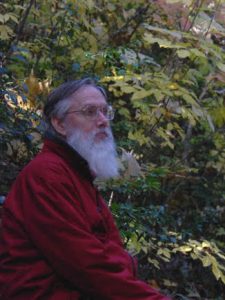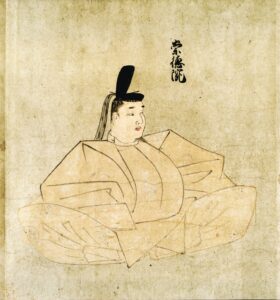
Sutoku, the 75th emperor of Japan (reigned 1123-1142), is known to those with an interest in Japanese literature primarily for a poem included in a 13th century anthology of poetry, the Hyakunin Isshu (1235 AD); for students of history he is known as a rebel and the catalyst of one of the most significant power shifts in Japanese history; and for those with an interest in fantasy, horror, and magic he is known as an onryō, or yōkai.
Born in 1119, he was named Akihito, although we will refer to him as Sutoku, the name given to him after his death. According to genealogical records, his father was emperor Toba (1103-56); however, in the next century a story surfaced that not Toba but the retired emperor Shirakawa was Sutoku’s father. His mother, Fujiwara Tamako (Shōshi), was the daughter of Fujiwara Kinzane. As a child she was adopted by Toba’s grandfather, Shirakawa, and he eventually had her marry Toba. She is said to have been exceedingly beautiful, promiscuous, and very intelligent. After becoming empress she was given the name Taikenmon’in.
Sutoku was enthroned in 1123, when he was four, and married a few years later. His empress, Kiyoko (1122-1182), was also called Kōkamon’in. She was the daughter of Fujiwara no Tadamichi (1197-64) who served as Regent or Chancellor during the majority of Sutoku’s life. She became consort in 1129, and empress in 1130. She was eight, he was eleven. The emperor and empress got along well but had no children.
Meanwhile, Toba’s attention shifted from Taikenmon’in to Fujiwara Nariko (1117-1160), who became his new favorite and received the name Bifukumon’in. In 1139 she had a boy, who was given to Kiyoko to raise. However, Sutoku wanted his own child. Whether or not it is because in 1139 he founded a temple, Jōshō-ji, (which was located where Kyoto’s Exhibition and Trade Center in Okazaki Park stands today) is unknown, but the next year Sutoku got the child he hoped would be his heir when his concubine Hyōenosuke no Tsubone gave birth to a boy.
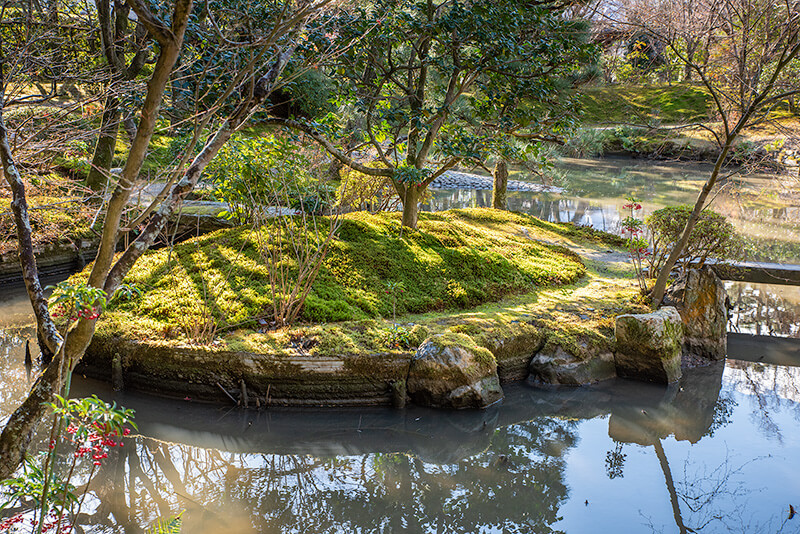
In 1141, Sutoku was forced to abdicate, and the baby which Toba and Bifukumon’in had given to Sutoku’s wife to raise was enthroned. He was later given the name Konoe. Taikenmon’in, seeing that her influence on Toba had all but disappeared, became a nun and moved to Hōkongō-in, where she died in 1145. The temple is known today for the beauty of its garden and its flowers (http://houkongouin.com).
As a retired emperor, Sutoku had his own palace. Although it no longer exists, the well that was on the palace grounds remains, on Nishi no Toin, just down from Sanjo. Called “yanagi no mizu,” (water of the willow), the well’s water has been used over the centuries by many people, including Sen no Rikyu. A dyeing company has the land now, and when I visited the shop I was invited in and given a glass of the well water – it was delicious. (Banba Senkogyo, 77 Ryusuicho, Nakagyo-ku, Kyoto http://www.black-silk.com/contents/about/yanagi/ )
Sutoku had a great interest in poetry. In the early 1140’s he gave an assignment to a select group of poets for each to submit a one hundred poem sequence. Sutoku himself participated, and the poem selected for the Hyakunin Isshu was among the poems in his sequence. There were thirteen participants, among whom were Fujiwara Akisue and his son Akisuke (leaders of the Rokujo group of poets), Fujiwara Shunzei (who was using the name Akihiro), and two of Taikenmon’in’s Ladies in Waiting. Completed in 1150, the sequence was named for the year period in which it was finished, Kyūan, and called the Kyūan Rokunen Hyakushu, Hundred Poem Sequences of the Sixth year of Kyūan.
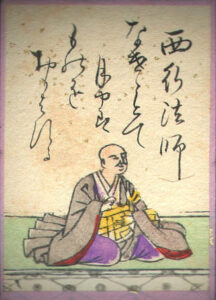
The next year, Sutoku commanded Akisuke to compile an imperial anthology of poetry. Completed in about 1151, it was given the title Shikawakashū. The anthology is interesting because it comes at the end of the predominance of the Kokinshū style and sets the stage for the beginning of a new style that culminates in that of the Shinkokinshū. Shunzei, who was young and relatively unknown at this time, was later to edit an imperial anthology himself, the Senzaiwakashū, which is known for its poems with yūgen, depth and mystery. He was also to head the Mukohidari poetry group, which was to eclipse all others. The famous poet priest Saigyo who knew Toba, Taikenmon’in, Shunzei, Sutoku, and the others, had one of his poems included in the Shikawakashū, although as an anonymous poem.
The emperor Konoe died in 1155. It was rumored that Sutoku was somehow involved in the young emperor’s illness, and even suggestions that he had used curses and evil magic to hasten the lad’s death. Sutoku (and apparently many others) believed that Sutoku’s own son would be enthroned next, but Toba chose Sutoku’s younger brother, the man known in history as Goshirakawa.
Sutoku was enraged. When Toba became sick, and his condition worsened, Sutoku began plotting. As Toba’s death approached, Sutoku moved to the Tanakaden in the Toba Palace to be close to his father.
Built by the Emperor Shirakawa just south of the capital near what was then the juncture of the Kamo and Katsura Rivers, the Toba Palace must have been an opulent array of magnificent buildings and gardens. The following photograph, taken of an illustration at the onsite display, shows what the area may have looked like.

Walking a bit south and then west from Kintetsu Takeda station, one arrives at Anrakujū-in, which is the location of emperor Toba’s tomb. That of the emperor Konoe is close by, as is the emperor Shirakawa’s. Walking on westward, through the Jonan-gu shrine, and crossing the highway, one comes to the Toba Palace Park. Historical markers roughly between Anrakujū-in, the park, and the Kyoto Minami IC of the Expressway, indicate where other parts of the Toba Palace area were. One of them, a bit northwest of Shrirakawa’s tomb, is the Tanakaden, the place where the retired emperor Toba died.

After Toba’s passing, in July of 1156, Sutoku mounted a rebellion with the intention of overthrowing Goshirakawa and installing his own son as emperor. The event is known as the Hogen Rebellion, or Hogen Insurrection (to use Sansom’s translation of Hogen no Ran). It was an event of enormous importance in Japanese history. The story is told in the Hogen Monogatari (translated most recently by Royall Tyler in Before HEIKE and After: HOGEN, HEIJI, JOKYUKI. 2016).
Just a few days after Toba’s death, to everyone’s surprise Sutoku left the Tanadaken and moved to the Shirakawa Kitaden, a palatial area which had been built by Shirakawa. (Today, a stele at the northwest corner of the Kyoto University Kumano Dormitory on Marutamachi marks the site of the Shirakawa Kitaden.) As he plotted with his advisors, Sutoku put out the call for his supporters to gather with their troops. At the same time Goshirakawa’s advisers realized what was happening and made their own plans. Among Goshirakawa’s supporters were Fujiwara no Tadamichi (the father of Sutoku’s wife Kiyoko), Taira no Kiyomori, and Minamoto no Yoshitomo. Afraid that waiting would mean defeat, Goshirakawa agreed to attack before dawn.
The fighting was fierce, but Sutoku’s men held firm. Minamoto no Yoshitomo, worried that with time passing more of Sutoku’s men might arrive to support him, sent a message from the front line to Goshirakawa about what to do, and was ordered to set fire to the mansion housing Sutoku and his advisors. Caught unawares, Sutoku and his forces panicked and scattered in disarray. Together with a few of his closest retainers, Sutoku escaped up into Mt. Nyoi, on past the part of the mountain now commonly referred to as Daimonji-yama, and spent a miserable night there before he decided to give up and become a priest. The next day he managed to get to Ninna-ji (just west of Ryōan-ji) where his (and Goshirakawa’s) brother was a priest. There he took priestly vows and shaved his head. It was quickly decided that Sutoku would be sent into exile.
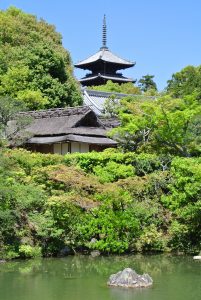
(photo John D.)
Sutoku was taken back south of the capital and put on a boat which would take him to exile in today’s Sakaide, in Kagawa prefecture. His son took priestly vows at Ninna-ji, and may have stayed there, or may have gone with his father. The boy’s mother, Hyōenosuke no Tsubone, went with Sutoku. Kiyoko stayed behind, and became a nun. Many of Sutoku’s supporters were executed.
While in exile, Sutoku repeatedly pleaded with the imperial court to be allowed to return to the capital. He copied sutras and had them sent to Goshirakawa to show his sincerity, but the emperor rejected them, and all of Sutoku’s pleas. There were rumors that Sutoku was using his own blood to write with, instead of black ink. There were fears that the sutras he copied contained some kind of special power, and curses, and were part of a plot to regain the throne. Strange disasters in the capital, especially involving those who had opposed him were blamed on Sutoku, with his evil magic, such as the deaths of Bifukumon’in in 1160, and Fujiwara no Tadamichi in 1164, six months before Sutoku’s own death.
Sutoku died in 1164 and is buried on Mt. Shiramine, in Kagawa (https://www.kunaicho.go.jp/ryobo/guide/075/index.html), next to Shiramine-dera, one of the 88 Shikoku pilgrimage temples. Although he never returned physically to the capital, some said that his revengeful spirit did, and rumors continued that Sutoku was responsible for deaths and natural disasters that followed. It said he had become an onryō (wrathful spirit), tengu, or yōkai.
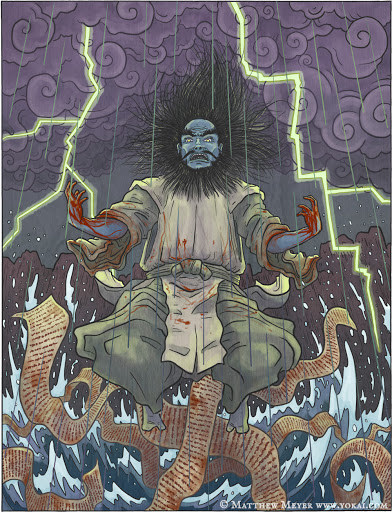
After Sutoku died, a woman who had been one of his favorites, Awa o Naishi (also pronounced Awa no Naiji), built a memorial to him in Kyoto where she and others prayed that his soul might find peace. Called the Sutoku Tenno Gobyō, it is located in the Gion area, just behind the Kaburenjo (https://ja.kyoto.travel/kiyomori/detail/022.html). Awa no Naishi had lived not far away, near the site of what is now the Yasui Konpira-gu shrine, and today Sutoku is one of three kami worshipped there. (http://www.yasui-konpiragu.or.jp/en/about See also the recent post in Green Shinto, http://www.greenshinto.com/wp/2020/05/26/animism-2-syncretic-yasui/ )
Later, after the fall of the Taira in 1185, Awa no Naishi moved to Jakkō-in, in Ohara, where she was lady in waiting to Taira no Tokiko, better known as Kenreimon’in, the daughter of the great Taira leader, Taira no Kiyomori. Kenreimon’in had been empress of the emperor Takakura, and she was the mother of the child emperor Antoku, who was drowned at Dan no Ura in the defeat of the Taira, in 1185. (http://www.jakkoin.jp/en/) In the Tale of the Heike, there is a moving account of the retired emperor Goshirakawa going to Jakkō-in to visit her, and being surprised to see Awa no Naishi there as well. They all cry as they remember the wars set in motion by Sutoku’s futile insurrection. The story is also in the Noh play Ohara goko.
The Hogen Rebellion of 1156 saw the rise of Taira no Kiyomori and Minamoto no Yoshitomo, who had supported Goshirakawa. In 1159, the Taira and Minamoto clans turned on each other in the Heiji Rebellion. The Taira won with Kiyomori at their head, but in 1180 the Genpei wars started, again between the Taira and the Minamoto, and this time the Taira were crushed and the victorious Minamoto, under Minamoto no Yoritomo, took control, and set up the Shogunate in Kamakura. Sutoku’s insurrection also resulted in the revival of the death penalty, and of the exile of an emperor; it had been centuries since either penalty had been imposed.
In 1177 it was decided that the name Sutoku would be used to refer to the man who had been the 75th emperor of Japan. In 1184, after a number of incidents attributed to Sutoku’s revengeful rage, the emperor Goshirakawa tried to calm and pacify the spirit of his deceased older brother. He held memorial services at Jōshō-ji, the temple Sutoku had founded in 1139, and at the Awata-gu, a shrine Goshirakawa had built at the site of the Shirakawa Kitaden, which had been the center of the fighting in the Hogen Insurrection. The Awata-gu is gone, having been destroyed by war in the fifteenth century, but a statue thought to have been there, the Sutoku Jizo (also referred to as the Hitokui Jizo – ‘people-eating Jizo’), can be seen at Sekizen-in (which is a few minutes walk east from Higashi-oji, on Kasugakita-dori, one block north of Marutamachi). A sign in front of the statue says “Do not take pictures of it.”
Sutoku’s place among the ranks of onryō (wrathful spirits) and yōkai (monsters) was secured in the 18th century with Ueda Akinari’s “Shiramine,” the first story in his Ugetsu Monogatari, translated by Anthony Chambers (Columbia, 2007) as Tales of Moonlight and Rain. “Shiramine” is the tale of a visit by the famous poet-monk Saigyo to pray at the mausoleum of Sutoku on Mt. Shiramine. In the story, Sutoku’s spirit appears and converses with Saigyo. Sutoku, looking dreadful, haggard, ragged, long straggly hair, gangly, and with a bellowing, angry, revengeful and wrathful voice, boasts about the death and destruction he has caused with his curses, and promises more carnage to come. Saigyo encourages him to reform, and says he will keep praying for him.
In 1868, as the Meiji period began, Sutoku’s spirit was finally allowed to return to Kyoto and a shrine was built for his spirit and that of another exiled emperor, Junnin (8th century). The shrine, called Shiramine-gu (after Sutoku’s mausoleum in Kagawa prefecture) is on Imadegawa, just east of Horikawa (http://shiraminejingu.or.jp/english/.
The poem Shunzei’s son Teika selected for the Hyakunin Isshu, which Sutoku had written for the Kyūan Hundred Poem Sequences several years before his revolt and exile, reads like the passionate call of a man for a dream which was never to come true.
瀬をはやみ se wo hayami
岩にせかるる iwa ni sekaruru
滝川の takigawa no
われても末に warete mo sue ni
逢はむとぞ思ふ awan to zo omou
The rapids so fast
that though the large rocks blocking
the waterfall river
split the flow, it will join again —
I so want to be with you again!

************************
For an interview with Nick Teele, see here. For his account of reviving a Kyoto Pilgrimage of 33 Temples, see here.
